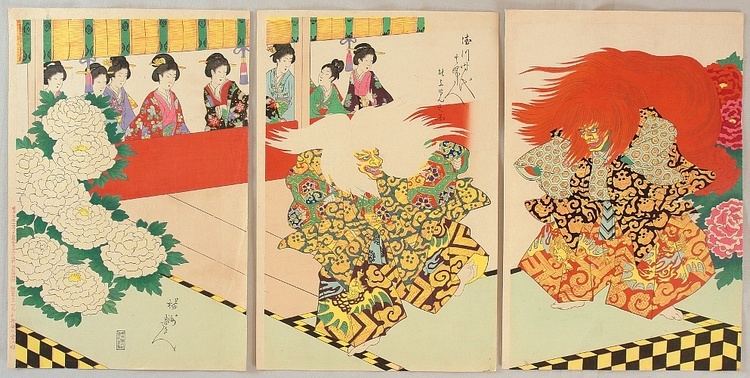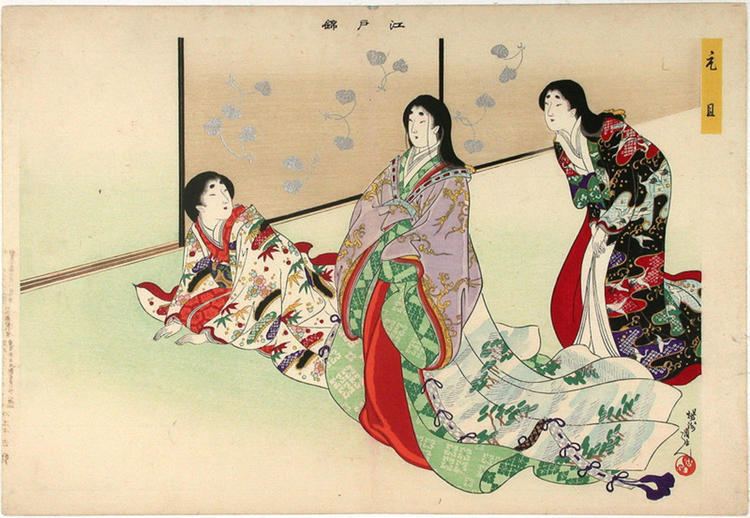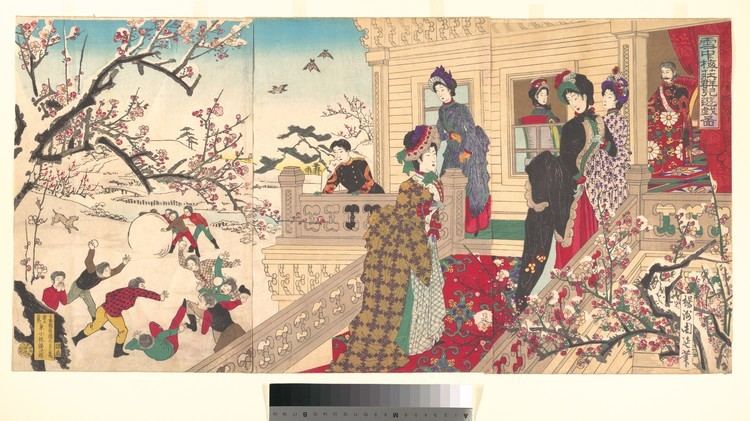Name Toyohara Chikanobu Books Chikanobu Period Ukiyo-e | Died 1912 Role Artist | |
 | ||
iMVD - Chikanobu
Meiji Japan: Reforming a Nation Through Western Development
Toyohara Chikanobu (豊原周延) (1838–1912), better known to his contemporaries as Yōshū Chikanobu (楊洲周延), was a prolific woodblock artist of Japan's Meiji period.
Contents
- iMVD Chikanobu
- Meiji Japan Reforming a Nation Through Western Development
- Names
- Military career
- Artists career
- Battle scenes
- Warrior prints
- Beauty pictures
- Historical pictures
- Famous places
- Portraits
- Enlightenment pictures
- Theatre scenes
- Memorial prints
- Womens pastimes
- Emperor Meiji pictures
- Contrast pictures
- Glorification of the Geisha
- Formats
- Selected works
- References

Names

Chikanobu signed his artwork "Yōshū Chikanobu" (楊洲周延). This was his "art name" (作品名) sakuhinmei. The artist's "real name" (本名) honmyō was Hashimoto Naoyoshi (橋本直義); and it was published in his obituary.

Many of his earliest works were signed "studio of Yōshū Chikanobu" (楊洲齋周延) Yōshū-sai Chikanobu; a small number of his early creations were simply signed "Yōshū" (楊洲). At least one triptych from 12 Meiji (1879) exists signed "Yōshū Naoyoshi" (楊洲直義).

The portrait of the Emperor Meiji held by the British Museum is inscribed "drawn by Yōshū Chikanobu by special request" (應需楊洲周延筆) motome ni ōjite Yōshū Chikanobu hitsu.
No works have surfaced that are signed either "Toyohara Chikanobu" or "Hashimoto Chikanobu".
Military career
Chikanobu was a retainer of the Sakakibara clan of Takada Domain in Echigo Province. After the collapse of the Tokugawa Shogunate, he joined the Shōgitai and fought in the Battle of Ueno.
He joined Tokugawa loyalists in Hakodate, Hokkaidō, where he fought in the Battle of Hakodate at the Goryōkaku star fort. He served under the leadership of Enomoto Takeaki and Ōtori Keisuke; and he achieved fame for his bravery.
Following the Shōgitai's surrender, he was remanded along with others to the authorities in the Takada domain.
Artist's career
In 1875 (Meiji 8), he decided to try to make a living as an artist. He travelled to Tokyo. He found work as an artist for the Kaishin Shimbun. In addition, he produced nishiki-e artworks. In his younger days, he had studied the Kanō school of painting; but his interest was drawn to ukiyo-e. He studied with a disciple of Keisai Eisen and then he joined the school of Ichiyūsai Kuniyoshi; during this period, he called himself Yoshitsuru. After Kuniyoshi’s death, he studied with Kunisada. He also referred to himself as Yōshū.
Like many ukiyo-e artists, Chikanobu turned his attention towards a great variety of subjects. His work ranged from Japanese mythology to depictions of the battlefields of his lifetime to women's fashions. As well as a number of the other artists of this period, he too portrayed kabuki actors in character, and is well known for his impressions of the mie (mise en scène) of kabuki productions. Chikanobu was known as a master of bijinga. images of beautiful women, and for illustrating changes in women's fashion, including both traditional and Western clothing. His work illustrated the changes in coiffures and make-up across time. For example, in Chikanobu's images in Mirror of Ages (1897), the hair styles of the Tenmei era, 1781-1789 are distinguished from those of the Keiō era, 1865-1867. His works capture the transition from the age of the samurai to Meiji modernity, the artistic chaos of the Meiji period exemplifying the concept of "furumekashii/imamekashii".
Chikanobu is a recognizable Meiji period artist, but his subjects were sometimes drawn from earlier historical eras. For example, one print illustrates an incident during the 1855 Ansei Edo earthquake. The early Meiji period was marked by clashes between disputing samurai forces with differing views about ending Japan's self-imposed isolation and about the changing relationship between the Imperial court and the Tokugawa shogunate. He created a range of impressions and scenes of the Satsuma Rebellion and Saigō Takamori. Some of these prints illustrated the period of domestic unrest and other subjects of topical interest, including prints like the 1882 image of the Imo Incident, also known as the Jingo Incident (壬午事変 jingo jihen) at right.
The greatest number of Chikanobu's war prints (戦争絵) sensō-e appeared in triptych format. These works documented the First Sino-Japanese War of 1894-1895. For example, the "Victory at Asan" was published with a contemporaneous account of the July 29, 1894 battle.
Among those influenced by Chikanobu were Nobukazu (楊斎延一) Yōsai Nobukazu and Gyokuei (楊堂玉英) Yōdō Gyokuei.
Battle scenes
Examples of battle scenes 戦争絵 (せんそうえ sensō-e) include:
Examples of scenes from this war include:
Examples of scenes from this war include:
Examples of scenes from this war include:
Examples of scenes from this war include:
Warrior prints
Examples of warrior prints (武者絵 (むしゃえ), Musha-e) include:
Beauty pictures
Examples of "beauty pictures" (美人画, Bijin-ga) include:
Historical pictures
Examples of historical scenes (史教画, Reshiki-ga) include: Recent (Meiji era) history
Ancient history
Famous places
Examples of scenic spots (名所絵, Meisho-e) include:
Portraits
Examples of portraits (肖像画, Shōzō-ga) include:
Enlightenment pictures
Examples of "enlightenment pictures" (文明開化絵, Bunmei kaika-e) include:
Theatre scenes
Examples of "kabuki scenes/actor portraits" (役者絵, Yakusha-e) include:
Memorial prints
Examples of "Memorial prints" (死絵, Shini-e) include:
Women's pastimes
Examples of "Etiquette and Manners for Women" (女禮式, joreishiki) include:
Emperor Meiji pictures
Examples of Emperor Meiji relaxing include:
Contrast pictures
Examples of "Contrast prints" (見立絵, Mitate-e) include:
Glorification of the Geisha
Examples of this genre include:
Formats
Like the majority of his contemporaries, he worked mostly in the ōban tate-e format. There are quite a number of single panel series, as well as many other prints in this format which are not a part of any series.
He produced several series in the ōban yoko-e format, which were usually then folded cross-wise to produce an album.
Although he is, perhaps, best known for his triptychs, single topics and series, two diptych series are known as well. There are, at least, two polyptych prints known.
His signature may also be found in the line drawings and illustrations in a number of ehon (絵本), which were mostly of a historical nature. In addition, there are fan prints uchiwa-e (団扇絵), as well as number of sheets of sugoroku (すごろく) with his signature that still exist and at least three prints in the kakemono-e format were produced in his latter years.
Selected works
In a statistical overview derived from writings by and about Hashimoto Toyohara, OCLC/WorldCat encompasses roughly 300+ works in 300+ publications in 2 languages and 700+ library holdings
